The Dell XPS 13 7390 2-in-1 Review: The Ice Lake Cometh
by Brett Howse on November 15, 2019 11:30 AM ESTBattery Life
Always a key metric on a mobile device, the Dell XPS 13 has historically offered excellent battery life. With the latest 10 nm processor, expectations are high. Dell keeps the battery capacity similar to the non-convertible model, officially rated for 51 Wh and with 50 Wh usable. Considering the small size of the device, the battery capacity is quite good, although a step down from the 60 Wh seen on the older models such as the 9360. But, battery capacity is only one part of the equation, with platform efficiency being the other.
To see how the XPS 13 7390 2-in-1 performs, we standardize the display brightness to 200 nits, and run it through three tests. The light test is very light web browsing. Our 2016 Web test is much more demanding and pulls a lot more CPU power into the equation. Finally, we test for video playback, which can often be the longest runtime due to the offloading of the video decode.
Light Web
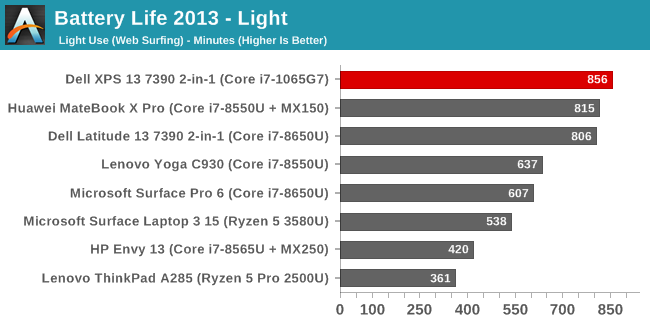
The XPS 13 7390 gets off to a strong start. Despite the larger physical display of the 16:10 13.4-inch panel, and the smaller battery capacity than some of the competition, the XPS 13 jumps to the top of the chart with over 14 hours of runtime on this light workload.
2016 Web

Our more demanding test always makes a big impact on efficient devices, forcing them to use the CPU a lot more and therefore using more power. But the Ice Lake platform does very well, maintaining its standing at the top with just a hair under 12 hours of runtime. Very impressive.
Movie Playback
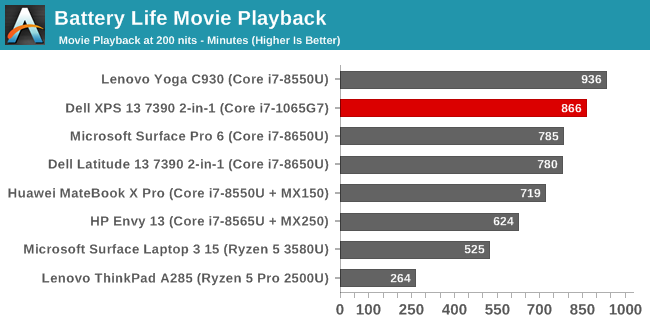
As we've seen in laptops over the last few years, Intel's now last-generation integrated UHD 620 GPU offers some spectacular battery life under video playback, as evidenced by how much longer these devices last in our video playback test, versus the more mixed workloads of our light web test. However things are a lot closer for the XPS 13; the Iris Plus (G7) GPU-equipped laptop only achieved ten minutes additional battery life over the light test. One device is not enough to make a definitive conclusion, but early indicators are that the norms for power consumption have changed on Intel's chips, and that movie playback and other ultra-light workloads that stress the GPU more than the CPU no longer hold a big advantage in power consumption. That being said, the device still achieved excellent battery life in this test, only being beaten by one other modern Ultrabook we’ve tested.
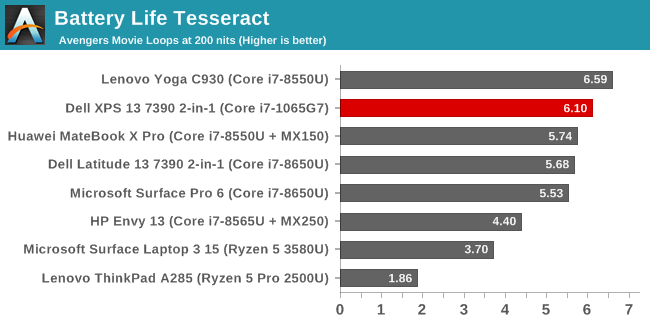
Our Tesseract score divides the movie playback time by the length of a long movie – The Avengers – to give a more practical view of the movie playback. If you had to, you could watch The Avengers six times in a row before needing to plug the laptop in.
Normalized Results

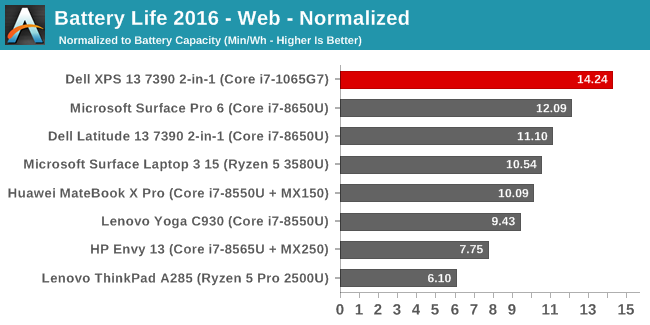
By removing the battery size from the equation we can get a peek at the platform efficiency, and the results are excellent for the first Ice Lake system we’ve tested. Much like how the first move to 14 nm in Broadwell brought a significant decrease in power usage, the XPS 13’s 10 nm Ice Lake platform achieves a significant step forward in efficiency in both our very light test, which is mostly idle time with small bursts of work, as well as the 2016 test which is much more demanding on the CPU.
The system power draw at idle, including the display power which is always the largest draw, is only around 3 Watts, which is quite good.
Battery Life Conclusion
Dell’s XPS 13 7390 2-in-1 brings a nice step forward in overall battery life, and unlike some of Dell’s earlier offerings it doesn’t try to do too much with excessive Content Adaptive Backlight Control which was a hindrance on older models of the XPS 13. For the current generation, CABC doesn’t appear to be leveraged at all.
With class-leading efficiency, the slightly smaller battery capacity is not a hindrance at all, with the Dell achieving excellent battery life results regardless of the 50 Wh of battery capacity.
Charge Time
Dell utilizes a Type-C charging adapter, which is always welcome on a modern laptop. The unit shipped with the XPS 13 2-in-1 is just a 45-Watt charger though, which is plenty to power this very efficient machine, but not enough power to provide much in the way of fast charging. With Express Charging enabled and the machine off, Dell claims 80% in one hour, but that goes down if the machine is on.
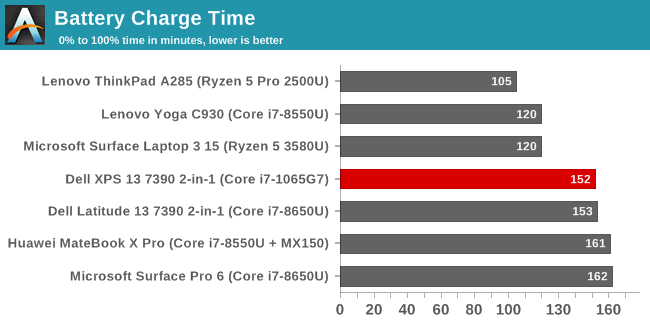
Overall charge time came in about average, at just a smidge over 2.5 hours. If you need more power and expansion, Dell offers a Type-C dock with a 130-Watt adapter, as well as a Thunderbolt dock with a 180-Watt power source.










108 Comments
View All Comments
abufrejoval - Friday, November 15, 2019 - link
First impression: This sure doesn't disappoint!1900x1200 makes a ton of sense (4k at 13" much less to my eyes), real CPU performance is better than Whiskey without draining the bottle, GPU performance is where I expected from a Skylake Iris 550 notebook I own, physical design sounds great... Perhaps I'd wait for a Lenovo variant, because I do type a lot.
With the higher-resolution, touch screen and a pen I'm not sure I'd ever be able to get it back from my daughter who can paint for hours even on a 6" mobile phone.
The most welcome surprise seemed the price: $1500 for 16GB and an i7 seems downright reasonable for what is most likely the current high-end.
Alas, when I went into the local (EU) configurator and added 32GB RAM, that added €1000 for what is essentially a €50 item (16 GB SO-DIMM). Sure it also added a 1TB NVME (€100 total or another €50 for the delta) and a 4k display I don't care about, but at that point I can't but call it the usual rip-off: I like my 4k at 42" and storage to be replacable.
So I'll hold back and onto my Lenovo S730 (16GB RAM, 1TB Samsung, AX200) for €1200 in May a little longer. That one also has an additional USB-C port in addition to the two Thunderbolts and that turns out to be really useful day-to-day, especially if your (mini) TB dock doesn't supply power, too.
But I note with satisfaction that at least in the mobile space Intel is still able to execute and I wish them well, while I won't remotely consider any Intel while there is Rome in the datacentre.
MASSAMKULABOX - Wednesday, November 20, 2019 - link
I think these are priced for the Business Market .. and its "car" pricing .. the base model is surprisingly cheap, but when you addd satnav,better wheels, heated sunroof, upgraded stereo , you've added 50% to the price. But 1000 bux for RAM is a trick learned from Apple.And where does this leave NVidia going forwrd? All their BAse(models) belong to us.
IntelUser2000 - Friday, November 15, 2019 - link
I'm suspicious of Anandtech's battery life tests for laptops.This is the only review where it doesn't regress and does significantly better than the Whiskey Lake generation.
Icelake does really well on idle but on actual usage like web browsing it plummets. Perhaps its time for them to update their tests.
yeeeeman - Saturday, November 16, 2019 - link
Phoronix review of the same laptops gets to the conclusion that ice lake is more power efficient than 14nm parts in both idle and heavy use.timecop1818 - Saturday, November 16, 2019 - link
Soldered in Killer Wireless garbage again. Not buying another Dell ever until they switch that shit out. I don't care if its made by Intel these days as long as they keep promoting that retarded branding shit in their non-gamer laptops, they will not have my money.Reflex - Saturday, November 16, 2019 - link
Literally just install the Intel AX200 drivers. Took me 5 mins and works great.timecop1818 - Saturday, November 16, 2019 - link
PCI IDs are different, no?Reflex - Sunday, November 17, 2019 - link
Doesn't seem to be. It will tell you its the incorrect driver but once you force it it will install, and future driver updates via Intel's updater will pick them up and install without a question.timecop1818 - Sunday, November 17, 2019 - link
Yeah, that means it's a different PCI ID. Because if they were included in the intel driver inf that would install without forcing. Intel would prolly be PCI\VEN_8086*DEV_xxxx and killer stuff probably uses their own vendor ID. Anyway, I'm happy with my current gemcut spectre x360 which has better screen and keyboard than XPS 13 anyway.Reflex - Sunday, November 17, 2019 - link
I hear its a good laptop, it was on my list until I noticed it didn't have a 32GB of RAM option. They both appeal to slightly different requirements IMO and I'd recommend either depending on the user and what they need.